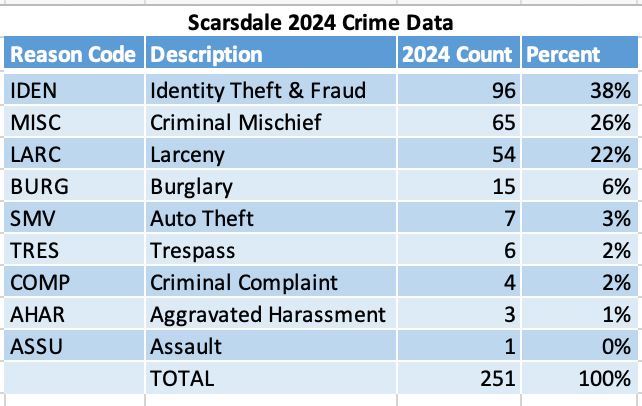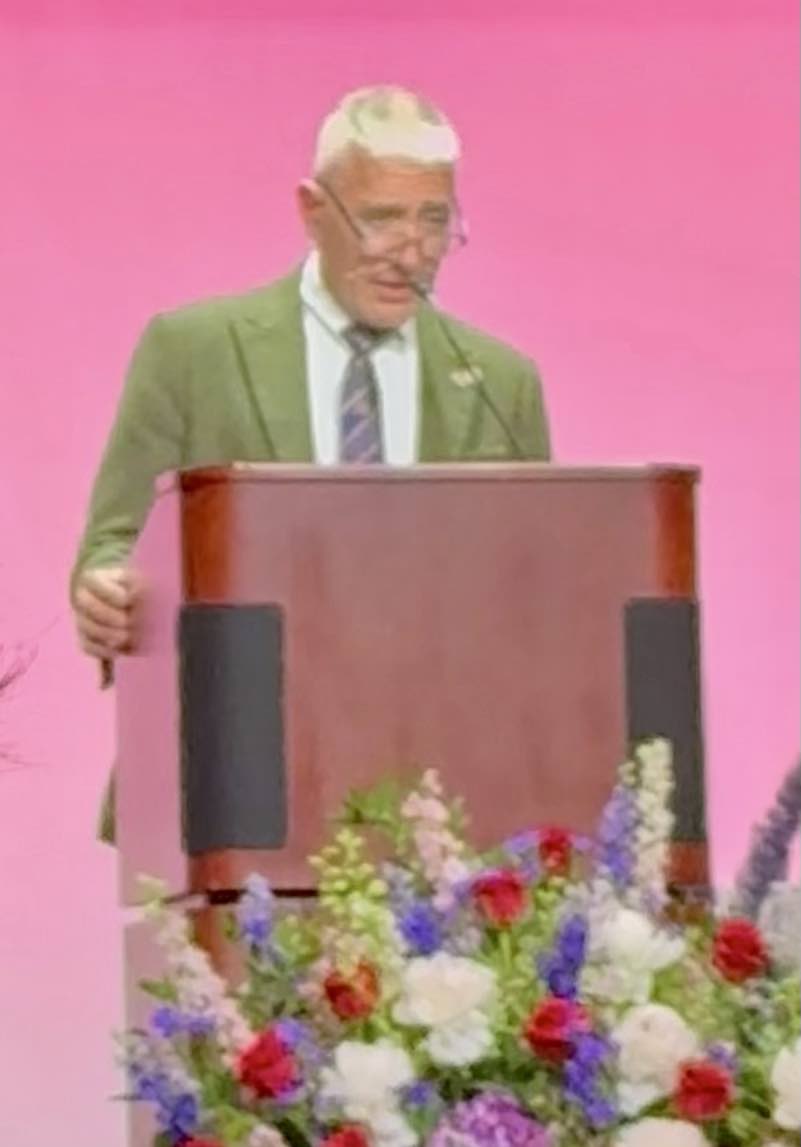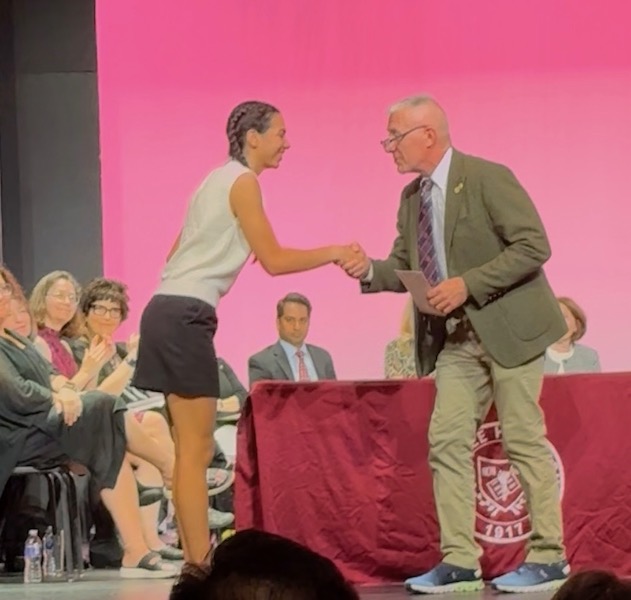Privacy vs. Policing: Scarsdale Surveillance Contract With Flock Reflects National Debate
- Details
- Written by: Joanne Wallenstein
- Hits: 3229
 (Written by Scarsdale10583 Publisher Joanne Wallenstein)
(Written by Scarsdale10583 Publisher Joanne Wallenstein)
“Don’t conflate this discussion with national issues.” That’s a line we’ve heard Scarsdale Mayor Justin Arest say a few times in defense of a controversial decision made by the Village Trustees to sign a contract with Flock Safety, a nationwide company that links local police departments with a national data security network.
Arest makes this statement at a time when mass surveillance systems like Flock’s are being used to target immigrants and citizens, sweeping up people without due process. The Mayor continually asserts that despite evidence to the contrary, Scarsdale’s data would be secure and it would not be shared with outside entities.
But as anyone with a bank account or a credit card knows, data is no longer secure.
And as anyone who reads the news is aware, our democracy is under attack. Lawmakers and judges are being threatened, assaulted and killed, free speech is no longer assured and there seem to be no limits to the power of law enforcement officers to terrorize the public.
How does all of this affect Scarsdale?
The Village is home to many from abroad, some permanent residents and others here on temporary visas. Residents employ housekeepers, gardeners, drivers, handymen and workers – some here legally and others without status. Increased surveillance can only help law enforcement target these people who are an integral part of our community. At a recent public hearing, many residents who hail from India and China, spoke with courage about the fear that surveillance instills.
Others simply don’t like the idea of being watched and tracked. They object to living in a police or surveillance state. The Village has imposed this system upon Scarsdale, without giving residents a choice.
Many are deeply concerned about our loss of personal liberties and threats to democracy. They are writing letters, demonstrating, and contributing to fight for their rights. The last thing they want is to have Scarsdale cooperate with a national network that is being used to target the population, an initiative that is being funded by the federal government, subject to the approval of a grant filed by Scarsdale Village.
To me it’s surprising that after the public outcry the Scarsdale Village Board and Police Department did not back down. Instead, they have dug in their heels, claiming that we need the system to fight crime, though the weekly police blotter is dominated by reports of washed checks, lost dogs and illegal signage. See the data on Scarsdale crime below. The Mayor says the adoption process for the contract was transparent and even blames their lack of communication on the loss of the Scarsdale Inquirer. Somehow the Village had time in March to solicit the support for the initiative from senators, assemblymen, clergy, and the school district but never found the opportunity to inform the public.
 The data shows that Flock is a solution in search of a problem.
The data shows that Flock is a solution in search of a problem.
But now the reasons for the when, why, and how this poor decision was made seem beside the point. The Board failed to assess public attitudes before signing the contract and are turning a deaf ear to constituents’ reactions after the deal was done.
The fact is that a seven-year, $1.8mm contract has been signed and the Village is moving forward with the purchase of cameras, license plate readers and drones, training for officers and the hardware and software to support the system.
At a recent meeting, a resident called for the Village to hold this decision to a public referendum but the Village Attorney said this was not within Village code. So there will be no vote.
The only means to change this seems to be a public campaign to demand that the Mayor immediately cancel the contract with Flock. As each day goes by, we have fewer options available to halt the erosion of our democracy. This is one thing you can do on a local level to protect our Village. Despite the Mayor’s claim, the Flock contract here has everything to do with the national scenario.
To voice your opinion, email the Mayor at Mayor@Scarsdale.gov and the Board of Trustees at PublicComments@Scarsdale.gov and tell them to “Stop Flock.”
Commenting on the contract, Myra Saul said, "Thank you for the comprehensive editorial regarding the new surveillance system in Scarsdale. The system is not in anyone’s interest at this time. What is most distressing is the insistence of our elected officials that there is nothing to see here. Every single iota of any consequence is usually discussed in minute detail (sometimes inordinately so) in our community. Why not here? Why the rush? Truly disappointing."
Nancy Alderman said, "No matter what one’s politics are, it has to be acknowledged that the way the United States is now being governed is very different than ever before. The President has been ruling by decree. This was not the way the founders of our country had planned for us. Now we see the same behavior being used by our local officials ruling our village.
We have always felt we had a voice in local school and government here. Until now.
Add to this mess, tension and fear of immigrants and the lack of security for data protection.
The mayor and board acted too quickly. Why? Please explain.
Justice Louis Brandeis said, “Sunlight is the best disinfectant.”
We depend on fact finding journalists to give the information.
Yes, The Scarsdale Inquirer is no more. Neither do subway tokens exist. There are new ways to pay the fare and still ride the subway. There are new ways to get the news. Thank you, Joanne Wallenstein for keeping us informed.
Mr. Mayor, don’t blame the lack of a print newspaper. Find a way to keep the citizens of Scarsdale informed. Why are you afraid of transparency?
The idea of our village government sneaking in secret surveillance equipment is doubly dirty and offensive."
Miriam Popp wrote, "Thank you for informing us of this significant and frightening issue.
Maybe it is time to start electing mayors and trustees who will better reflect the will of the community.
Contrast the apparent reluctance to obtain a full community vetting of this matter with the numerous emails we are all getting to comment on youth sports. If this can be done for youth sports, surely it can be done on surveillance. In fact, it seems like Scarsdale debates ever minute issue ad nauseam and for months and years. One has to wonder why this is being pushed through at lightening speed."
Scarsdale Police Issue General Orders for Use of Cameras, License Plate Readers and Drones
- Details
- Written by: Joanne Wallenstein
- Hits: 2804
 (Written by Joanne Wallenstein) If you drove to Manhattan, Long Island or New Jersey in the past few days, it may have taken far longer than you planned. Traffic was snarled for hours at the bridges not due to construction, an accident or the weather. Why? A multi-agency law enforcement operation set up roadblocks at the entrances to the bridges to raise funds for the departments. They stopped unregistered vehicles, people with suspended licenses, toll violators and drivers who use ghost plates to bypass the tolls.
(Written by Joanne Wallenstein) If you drove to Manhattan, Long Island or New Jersey in the past few days, it may have taken far longer than you planned. Traffic was snarled for hours at the bridges not due to construction, an accident or the weather. Why? A multi-agency law enforcement operation set up roadblocks at the entrances to the bridges to raise funds for the departments. They stopped unregistered vehicles, people with suspended licenses, toll violators and drivers who use ghost plates to bypass the tolls.
This enforcement was done at the busiest time on the roadways – during rush hour on weekday evenings and at 5 pm on Sunday, when many were traversing the boroughs.
Reports say, “MTA Bridges and Tunnels officers, the NYPD and regional law enforcement partners made 21 arrests, seized 21 vehicles and issued 793 summonses in a joint two-day interagency operation focused on quelling ghost plates and persistent toll violators, transit officials announced on Sunday.
The crackdown took place at the Robert F. Kennedy Bridge on Thursday and the Throgs Neck Bridge, George Washington Bridge and Lincoln Tunnel on Friday.
In this time, officers seized 21 vehicles for numerous violations including unpaid tolls, unregistered vehicles, suspended licenses and other traffic infractions, officials said.
Twenty-one people were arrested and 793 summonses were issued to remedy the $586,000 in unpaid tolls and fees, judgments and debts the scofflaws racked up.”
I was caught in two of these roadblocks which held up traffic for miles and I sat in the car for hours.
This happened at the same time that the Village of Scarsdale has announced plans to purchase $1.8mm in surveillance equipment from Flock Safety which will enhance their ability to conduct similar operations. On April 8 Village Trustees passed a resolution to purchase license plate readers, cameras and a drone, all to be used to increase surveillance in the Village. This was done without public notice or an opportunity for public comment.
Though the Mayor originally said that the equipment would only be purchased if the Village received a federal grant, in the 2025-26 Village budget $200,000 of Scarsdale taxpayer money was allocated for Police Technology. And now it appears that the Village may go ahead with this plan, with or without the federal grant. Last week the Mayor announced a work session about the purchase but the agenda is not about the merits of the plan, it is about the policy for its use.
The Village Manager’s office has drafted General Orders for the use of drones, license plate readers and cameras. It is not clear whether or not these General Orders are subject to the same review policies as Village Code. You can see the draft here.
The Scarsdale Village Board will hold a public meeting at Village Hall on Tuesday June 10 at 5:30 pm to discuss the surveillance technology. Public comment will be limited to 3 minutes. If you are not able to attend, you may participate remotely via Zoom. Here are instructions:
Here is the link to the new policies:
If you have concerns about living in a police state, attend the meeting or watch it online on Tuesday June 10 at 5:30 pm or email Mayor@Scarsdale.gov.
Faceoff Specialists and Former Teammates Meet on NCAA Stage
- Details
- Written by: Joanne Wallenstein
- Hits: 1458
 Colby Baldwin signs an autograph.OOn the weekend of May 24, 2025 Paul Lamonaca, a senior at Syracuse University and Colby Baldwin, a sophomore, at Penn State were both a part of the NCAA Lacrosse Final Four Tournament. While Cornell ultimately won the championship, it was a proud moment to see these two young men competing at such a high level. Both athletes were faceoff specialists and played an integral role in getting their teams to this elite level of competition.
Colby Baldwin signs an autograph.OOn the weekend of May 24, 2025 Paul Lamonaca, a senior at Syracuse University and Colby Baldwin, a sophomore, at Penn State were both a part of the NCAA Lacrosse Final Four Tournament. While Cornell ultimately won the championship, it was a proud moment to see these two young men competing at such a high level. Both athletes were faceoff specialists and played an integral role in getting their teams to this elite level of competition.
SHS coach James Synowiez travelled with his entire family and several members of the Scarsdale team to see both boys play. It was an electric weekend at Gillette Stadium in Foxborough where Coach Synowiez and his family did a quick change from their Penn State gear to their Syracuse gear to support two of his former players.
Adding to the excitement, both of the boys’ mothers are longtime Scarsdale educators, each having dedicated over 25 years to the district. It is a wonderful achievement for both families and an inspiring moment for the Scarsdale Lacrosse community.
 Paul Lamanoca and Coach Synowiez
Paul Lamanoca and Coach Synowiez
 Coach Synowiez's Family
Coach Synowiez's Family
 The Lamonaca Family
The Lamonaca Family
AFC Urgent Care Comes to Scarsdale
- Details
- Written by: Joanne Wallenstein
- Hits: 3650
 A new health care solution promises quality, convenient care. American Family Care Scarsdale has opened its doors to the public on Monday, May 12th at 777 White Plains Road in Scarsdale. The Grand Opening was celebrated by many community members, dignitaries, and business leaders who welcomed the new health care provider at the ribbon cutting ceremony. AFC is the second largest privately owned operator of urgent care and accessible primary care facilities in the country. With this new state-of-the-art facility, we will provide accessible and affordable healthcare services for non-life-threatening illness and injuries to the residents of Scarsdale and its surrounding communities.
A new health care solution promises quality, convenient care. American Family Care Scarsdale has opened its doors to the public on Monday, May 12th at 777 White Plains Road in Scarsdale. The Grand Opening was celebrated by many community members, dignitaries, and business leaders who welcomed the new health care provider at the ribbon cutting ceremony. AFC is the second largest privately owned operator of urgent care and accessible primary care facilities in the country. With this new state-of-the-art facility, we will provide accessible and affordable healthcare services for non-life-threatening illness and injuries to the residents of Scarsdale and its surrounding communities.
Dr. Akshay Gupta, the Center’s Medical Director and Head Physician stated, “I'm excited about opening an urgent care center because it allows me to make a real difference in the community by providing accessible, timely, and high-quality care to people when they need it most. It's an opportunity to bridge gaps in healthcare and ensure that patients receive the attention they deserve without long waits or unnecessary stress.”
The center offers a wide array of services including but not limited to; onsite laboratory and X-Ray services, general urgent care needs, physicals (DOT, sports, school, employment), drug testing, vaccinations, and immunizations. The new facility will have extended hours from M-F 8:00 am - 8:00 pm/ S-S 8:00 am – 5:00 pm, 7 days a week and no appointment necessary. Conveniently located in the same shopping center as Decicco’s facing the entrance on White Plains Road.
AFC Scarsdale is a modern urgent care facility that dedicates its time and commitment to our patients by providing high quality, convenient and affordable health care to the community. It’s our mission to open an urgent care that offers a patient-centric experience, where we respect the individual patient's needs, preferences, and values to provide the best healthcare in a kind and caring environment.
(Photographed by Peter T. Michaelis Photography)
Garrett Capobianco To Serve as District Governor for the Rotary
- Details
- Written by: Sharon Higgins
- Hits: 1092
 Garrett CapobiancoThe history of The Rotary Club, a civil service club, was founded in Chicago at the turn of the 20th century (1905). The name “rotary” was used as a reference to the rotating weekly meetings held at the varied business offices of the original members who gathered to organize and plan service projects for their community. Today, the Rotary Club has expanded from the original three members in the first club in Chicago, to a global network of 1.4 million with 35,000 local clubs in over 200 countries. The Scarsdale local chapter of The Rotary Club still continues this mission with the same purpose and describes itself as “a club of neighbors, friends, leaders and problem solvers who see a world where people unite and take action to create lasting change…in our communities, and in ourselves”. They focus their voluntary service projects around the original seven broad areas; “promoting peace, fighting disease, providing clean water, saving mother and children through accessible health care and other services, supporting basic education and literacy, growing local economies and protecting the environment.” The original Scarsdale chapter of The Rotary Club founded in 1923 had 16 members. At the 25th anniversary of the club in 1948, the chapter grew to 67 members and is still going strong today.
Garrett CapobiancoThe history of The Rotary Club, a civil service club, was founded in Chicago at the turn of the 20th century (1905). The name “rotary” was used as a reference to the rotating weekly meetings held at the varied business offices of the original members who gathered to organize and plan service projects for their community. Today, the Rotary Club has expanded from the original three members in the first club in Chicago, to a global network of 1.4 million with 35,000 local clubs in over 200 countries. The Scarsdale local chapter of The Rotary Club still continues this mission with the same purpose and describes itself as “a club of neighbors, friends, leaders and problem solvers who see a world where people unite and take action to create lasting change…in our communities, and in ourselves”. They focus their voluntary service projects around the original seven broad areas; “promoting peace, fighting disease, providing clean water, saving mother and children through accessible health care and other services, supporting basic education and literacy, growing local economies and protecting the environment.” The original Scarsdale chapter of The Rotary Club founded in 1923 had 16 members. At the 25th anniversary of the club in 1948, the chapter grew to 67 members and is still going strong today.
It was just recently announced that past Scarsdale Rotary Club President, Mr. Garrett Capobianco was selected by the District Nominating Committee to be the next District Governor for District 7230 for the Rotary Year 2025-26. Current District Governor Marty Schulman who announced his successor, describes this leadership position as the following: “the district governor appoints assistant governors from among the Rotarians of the district to assist in the management of Rotary activity and multi-club projects in the district. Rotary District 7230 (which includes The Scarsdale Rotary Club), home to the United Nations in New York, is the governing organization of 50 Rotary Clubs, 6 Rotaract Clubs, and 21 Interact Clubs spanning the New York Metro area (Manhattan, The Bronx, Staten Island, Westchester) and Bermuda.”
What makes this such a remarkable appointment is that Mr. Capobianco is not only a current resident of Scarsdale but also a Scarsdale High School grad, class of 1984. He grew up in Fox Meadow/Heathcote neighborhoods and lives in Greenacres now as he continues to give back to the community. It is the first time a Scarsdale resident has been named to this position and a very great honor. Dr. Elizabeth Frost, a Scarsdale Rotary Club member, describes Mr. Capobianco’s new position, “He is travelling all over now to take the word of our projects, getting more support and generally putting Scarsdale even more on the map. Last year, we were able to finance and thus create the first physician anesthesiologist in the entire county of Liberia.”
Local Scarsdale Rotary Club work occurred just this past Wednesday evening (May 7th) at the Scarsdale High School Awards Night. Each year the Scarsdale Rotary Club presents $1500 scholarship awards to Scarsdale High School seniors who emulate the Rotary motto of “Service Above Self.” Student candidates are selected by the high school administration and interviewed by a committee of Scarsdale Rotary Club members who determine the recipients.
The committee explained that this year’s “six candidates were all outstanding selections who represented SHS admirably and  instilled confidence in the committee that our society will be in the good hands of such future leaders”. The first of three recipients of the Scarsdale Rotary Club scholarship awards for 2025, Avery Dickstein, is an avid student environmentalist who is co-president of the Project Green Club where she is working to reduce the use of plastic in local eateries. The next recipient, Kamila El Moselhy is a co-founder of the SHS Muslim Club and after October 7th she reached out to her peers in the Jewish Culture Club to brainstorm ideas to bring their communities together, demonstrate unity, and help civilians affected by the war. Lastly, Amelia Fader serves as a Public Relations/Recruitment Officer of the SHS Innocence Club which helps spread awareness about unjust incarceration practices and advocates for criminal and social justice reform. She is also the Programming Officer of the SHS UNICEF Club which advocates for the wellness and human rights of children around the world. The District Governor elect of Rotary, Garrett Capobianco, attended the SHS Awards Assembly on May 7th and presented the awards to each student.
instilled confidence in the committee that our society will be in the good hands of such future leaders”. The first of three recipients of the Scarsdale Rotary Club scholarship awards for 2025, Avery Dickstein, is an avid student environmentalist who is co-president of the Project Green Club where she is working to reduce the use of plastic in local eateries. The next recipient, Kamila El Moselhy is a co-founder of the SHS Muslim Club and after October 7th she reached out to her peers in the Jewish Culture Club to brainstorm ideas to bring their communities together, demonstrate unity, and help civilians affected by the war. Lastly, Amelia Fader serves as a Public Relations/Recruitment Officer of the SHS Innocence Club which helps spread awareness about unjust incarceration practices and advocates for criminal and social justice reform. She is also the Programming Officer of the SHS UNICEF Club which advocates for the wellness and human rights of children around the world. The District Governor elect of Rotary, Garrett Capobianco, attended the SHS Awards Assembly on May 7th and presented the awards to each student.
A celebration marking Mr. Capobianco’s appointment as District Governor, will be held at the Scarsdale Women’s Club on May 31st starting at 6:30pm. Scarsdale Rotary is celebrating its 102nd year serving local, national, and international needs through projects and fundraising. More information can be found on its website: scarsdalerotary.org New members are always welcome. The club meets weekly on Tuesdays either by ZOOM or in person.










